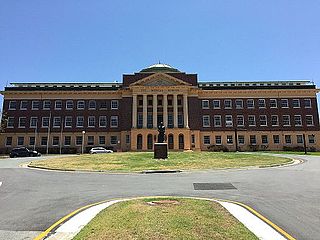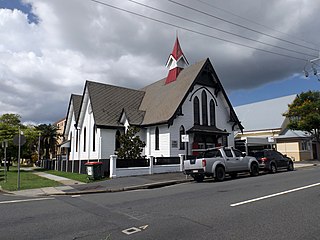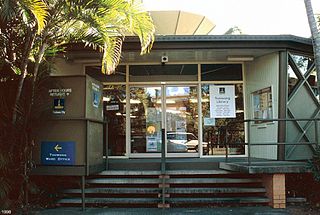
Chateau Nous is a heritage-listed villa at 1 Rupert Terrace, Ascot, Queensland, Australia. It was designed by Douglas Francis Woodcraft Roberts and built from c. 1937 to 1940s. It was added to the Queensland Heritage Register on 21 October 1992.

Musket Villa is a heritage-listed detached house at 251 Lancaster Road, Ascot, Queensland, Australia. It was designed by architectural firm Hall and Prentice and was built in 1923. It is also known as Lancaster Gables. It was added to the Queensland Heritage Register on 28 July 2000.

University of Queensland Mayne Medical School is a heritage-listed university building at 288 Herston Road, Herston, City of Brisbane, Queensland, Australia. It was designed by Raymond Clare Nowland and built from 1938 to 1939. It is also known as University of Queensland Medical School. It was added to the Queensland Heritage Register on 24 June 1999.

Torbreck, or the Torbreck Home Units, was the first high-rise and mix-use residential development in Queensland, Australia. These heritage-listed home units are located at 182 Dornoch Terrace, Highgate Hill, Brisbane. Designed by architects Aubrey Horswill Job and Robert Percival Froud, construction began in 1957 and was completed three years later in 1960 by Noel Austin Kratzmann. The project acquired the name 'Torbreck' to recognise a small, gabled timber cottage that previously occupied the site. It was added to the Queensland Heritage Register on 17 December 1999.

The Mowbraytown Presbyterian Church is a heritage-listed church precinct at 22-28 Mowbray Terrace, East Brisbane, City of Brisbane, Queensland, Australia. It was designed by architect Alexander Brown Wilson and built from 1885 to c. 1916. It is also known as East Brisbane Presbyterian Church. It was added to the Queensland Heritage Register on 22 October 1993.

Australian Estates No.1 Store is a heritage-listed former warehouse and now apartments at 50 Macquarie Street, Teneriffe, Brisbane, Queensland, Australia. It was designed by Montague Stanley and built from c. 1926 to 1927 by Stuart Brothers (Sydney). It is now known as the Saratoga Woolstore Apartments. It was added to the Queensland Heritage Register on 21 October 1992.

Scott Street Flats is a heritage-listed apartment block at 2 Scott Street, Kangaroo Point, City of Brisbane, Queensland, Australia. It was designed by Elina Mottram and built to c. 1925 by W B Johnstone. It is also known as Scott House. It was added to the Queensland Heritage Register on 29 April 2003.

The Main Roads Building is a heritage-listed office building at 477 Boundary Street, Spring Hill, City of Brisbane, Queensland, Australia. It was designed by Karl Langer and built in 1967 by Cyril Porter Hornick. It was added to the Queensland Heritage Register on 13 June 2014.

The Toowong Municipal Library Building is heritage-listed former public library at 579–583 Coronation Drive, Toowong, City of Brisbane, Queensland, Australia. It was designed by James Birrell and built in 1961 by Stuart Brothers. It was added to the Queensland Heritage Register on 28 August 1998. In 2001, the library moved to Toowong Village Shopping Centre and the original building has been used as business premises.

Craigston is a heritage-listed apartment block at 217 Wickham Terrace, Spring Hill, City of Brisbane, Queensland, Australia. It was designed by Atkinson & Conrad and built in 1927. It was added to the Queensland Heritage Register on 21 October 1992.

Oogarding is a heritage-listed villa at 100 Simpsons Road, Bardon, City of Brisbane, Queensland, Australia. It was designed by architect Mervyn Rylance and built in 1940 by Jan Cupka. It was extended in 1964 and 1965. It was added to the Queensland Heritage Register on 23 June 2000.

Greystaines is a heritage-listed 8 bedroom, 6 bathroom, 3 kitchen house with 6 car garage at 240 Kingsford Smith Drive, Hamilton, City of Brisbane, Queensland, Australia. A substantial, three-storeyed building, it was designed by George Rae, a Brisbane-based architect who designed some of Brisbane's best interwar buildings, and built from 1934 onwards by Douglas Francis Roberts for Mr Sydney James Dove and his wife Audree Thomasina Dove. It was also known as Greystaines Flats. It was added to the Queensland Heritage Register on 26 May 2006.

Paddington Tramways Substation is a heritage-listed former electrical substation at 150 Enoggera Terrace, Paddington, City of Brisbane, Queensland, Australia. It was designed by Roy Rusden Ogg and built from 1929 to 1930. It was added to the Queensland Heritage Register on 22 March 1993.

Santa Barbara is a heritage-listed villa at 209 Moray Street, New Farm, City of Brisbane, Queensland, Australia. It was designed by Eric Percival Trewern and built from 1929 to 1930 by DF Roberts. It was added to the Queensland Heritage Register on 28 January 2000.
Julius Street Flats is a heritage-listed group of seven apartment blocks at 15 Julius Street, New Farm, City of Brisbane, Queensland, Australia. They were built from 1934 to early 1950s. The apartment blocks are called Ardrossan, Green Gables, Julius Lodge, Syncarpia, Ainslie, Pine Lodge and Evelyn Court. They were added to the Queensland Heritage Register on 4 August 1997.

Wickham House is a heritage-listed office building at 155–157 Wickham Terrace, Spring Hill, City of Brisbane, Queensland, Australia. It was designed by Francis Richard Hall and built from 1923 to 1924 by F J Corbett. It was added to the Queensland Heritage Register on 23 June 2000.

Victoria Flats is a heritage-listed apartment block at 369 Gregory Terrace, Spring Hill, City of Brisbane, Queensland, Australia. It was designed by architect Thomas Blair Moncrieff Wightman and built c. 1922 by Cheesman & Bull. It is also known as Kilroe's Flats and Morella, Carinyah, Lumtah and Neerim. It was added to the Queensland Heritage Register on 30 March 2001.

Brisbane Dental Hospital and College is a heritage-listed former dental hospital at 168 Turbot Street, Brisbane City, Queensland, Australia. It was designed by Raymond C Nowland and built from 1938 to 1941 by the Queensland Department of Public Works. It was added to the Queensland Heritage Register on 23 April 1999.

Masel Residence is a heritage-listed detached house at 98 High Street, Stanthorpe, Southern Downs Region, Queensland, Australia. It was designed by Charles William Thomas Fulton and built from 1937 to 1938 by Kell & Rigby. It is also known as Diamond Residence. It was added to the Queensland Heritage Register on 7 February 2005.

Brisbane Boys' College Buildings are the heritage-listed private school buildings at Brisbane Boys' College, 55 Moggill Road, Toowong, City of Brisbane, Queensland, Australia. They were built from 1930 to 1950. They were added to the Queensland Heritage Register on 21 October 1992.






















